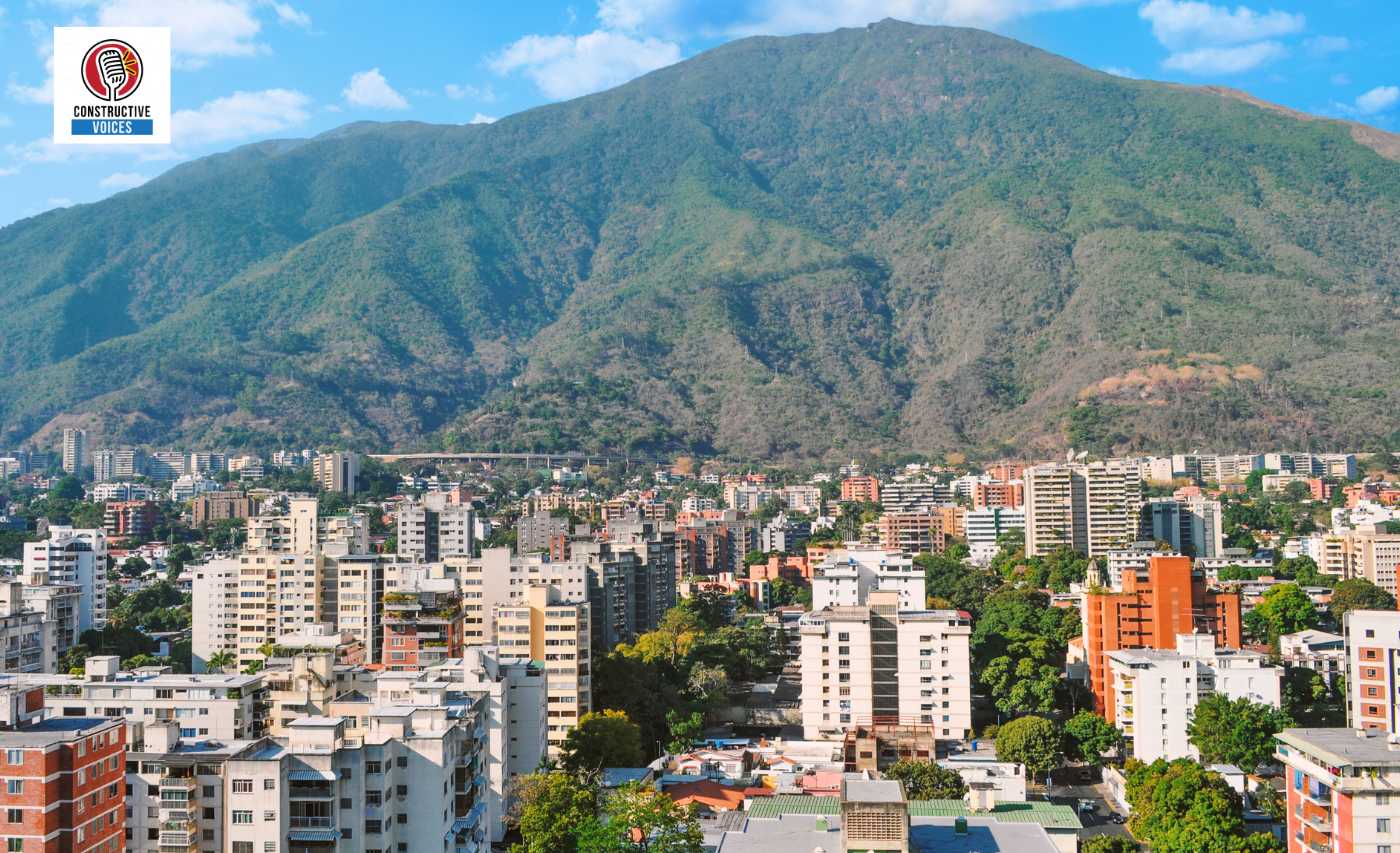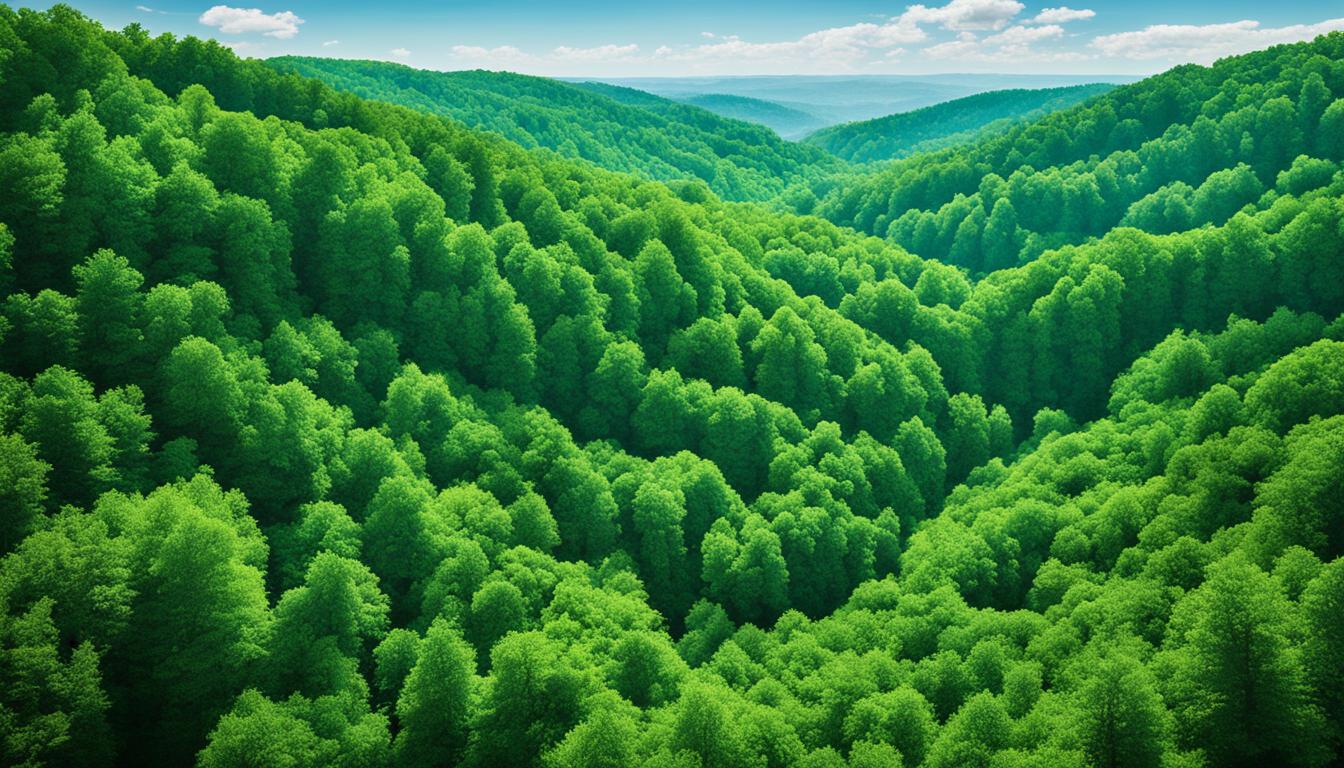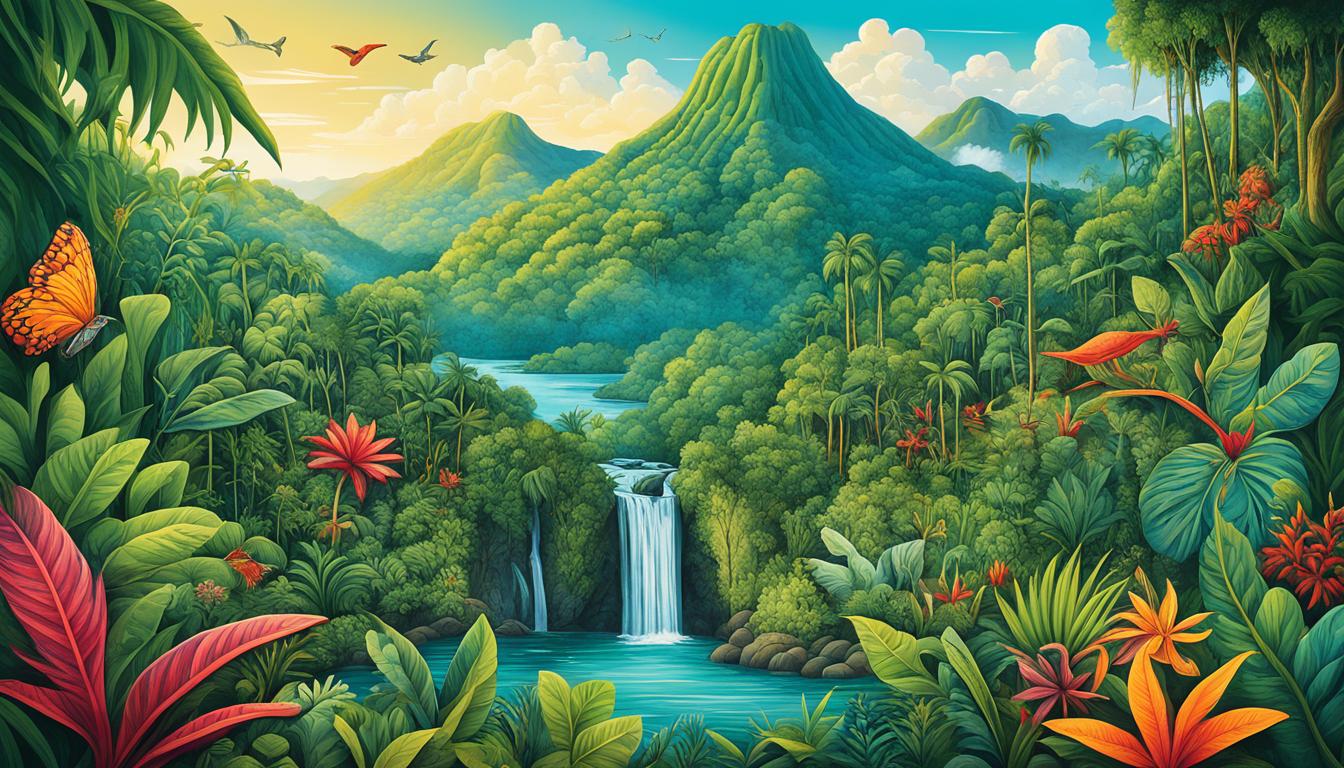Vanuatu Biodiversity and the Built Environment
Vanuatu, a tropical paradise known for its breathtaking natural beauty, is home to a remarkable array of plant and animal species. However, the delicate balance of Vanuatu’s biodiversity is under threat. The destruction of habitats, overexploitation of natural resources, and the challenges posed by climate change call for urgent conservation efforts and sustainable practices.
Vanuatu, being home to several endemic plants and marine life, holds significant value in terms of biodiversity conservation. From the iconic Pterocarpus indicus and Pandanus tectorius to the vibrant coral formations and diverse aquatic creatures, Vanuatu’s flora and marine biodiversity captivate visitors from around the world.
Understanding the origins of Vanuatu’s unique biodiversity reveals its close evolutionary connections with neighboring countries like Solomon Islands, Fiji, Australia, and New Caledonia. However, Vanuatu’s biodiversity also possesses distinct characteristics, creating a fascinating biogeographic divide within its islands.
Key Takeaways
- Biodiversity conservation in Vanuatu is crucial for sustainable development and environmental protection.
- Vanuatu’s unique geographical features have resulted in rapid subspeciation and speciation, contributing to its rich flora and marine biodiversity.
- The destruction of habitats and the overexploitation of natural resources pose significant threats to Vanuatu’s biodiversity.
- Efforts should be made to integrate indigenous knowledge and sustainable architecture practices into conservation strategies.
- Climate change adaptation strategies are essential for preserving Vanuatu’s biodiversity in the face of environmental challenges.
Origins of Vanuatu’s Biodiversity
Vanuatu’s unique biodiversity is shaped by its geographical proximity to neighboring countries, including Solomon Islands, Fiji, Australia, and New Caledonia. The flora and fauna of Vanuatu exhibit closer affinities with Solomon Islands, showcasing shared species and evolutionary connections. However, Vanuatu’s biodiversity also possesses distinct characteristics, making it a hub of endemic species.
One notable feature of Vanuatu’s biodiversity is the biogeographic divide within the country itself. There are discernible differences in species composition and distribution between the islands in the north and south of Vanuatu. This division creates a fascinating array of species and habitats, contributing to the overall richness of Vanuatu’s biodiversity.
Additionally, Vanuatu’s reef ecosystems play a crucial role in its biodiversity wealth, akin to Australia’s Great Barrier Reef and New Caledonia. These vibrant reef ecosystems support a diverse array of marine life and provide vital habitats for numerous species.
Distinctness and Affinities
Vanuatu’s biodiversity showcases a blend of shared species with neighboring regions and unique endemic species. The presence of common species with Solomon Islands indicates their historical connectivity and evolutionary links. However, Vanuatu’s biodiversity stands apart, with its own endemic species that have evolved and adapted to its unique environmental conditions.
The biogeographic divide within Vanuatu further enhances its distinctiveness. Species distribution patterns vary between the northern islands, influenced by their proximity to Solomon Islands, and the southern islands, which exhibit affinities with New Caledonia and Fiji.
Diversity in Reef Ecosystems
Vanuatu’s reef ecosystems are abundant and diverse, providing crucial habitats for numerous species. These reefs are teeming with vibrant coral formations, colorful fish, and other marine organisms. The diversity of these reef ecosystems contributes significantly to Vanuatu’s overall biodiversity richness, similar to the world-renowned reef systems of Australia’s Great Barrier Reef and New Caledonia.
These reef ecosystems play a vital role in supporting various species, creating intricate food webs, and providing essential breeding grounds for marine life. Their conservation and protection are paramount to the preservation of Vanuatu’s biodiversity.
Faring of Vanuatu’s Biodiversity
Vanuatu, known for its remarkable biodiversity, is facing a concerning decline in species populations. Limited data, combined with habitat degradation and human activities, has led to the extinction or endangered status of several species. For instance, the giant clams and black flying foxes, once abundant in Vanuatu, are now on the verge of extinction. This decline can be attributed to overcollecting, hunting, and habitat degradation.
Understanding the magnitude of the biodiversity decline in Vanuatu requires comprehensive research and monitoring programs. These initiatives are vital for assessing the current state of Vanuatu’s species and identifying urgent conservation priorities. Protecting endemic species in Vanuatu is particularly crucial as they play a significant role in maintaining the ecological balance of the region.
To ensure the long-term preservation of Vanuatu’s biodiversity, it is essential to prioritize conservation efforts and promote sustainable tourism. By raising awareness about the decline of species and the impacts of habitat degradation, we can inspire individuals, communities, and organizations to take action. Together, we can make a difference in safeguarding Vanuatu’s unique and invaluable natural heritage.
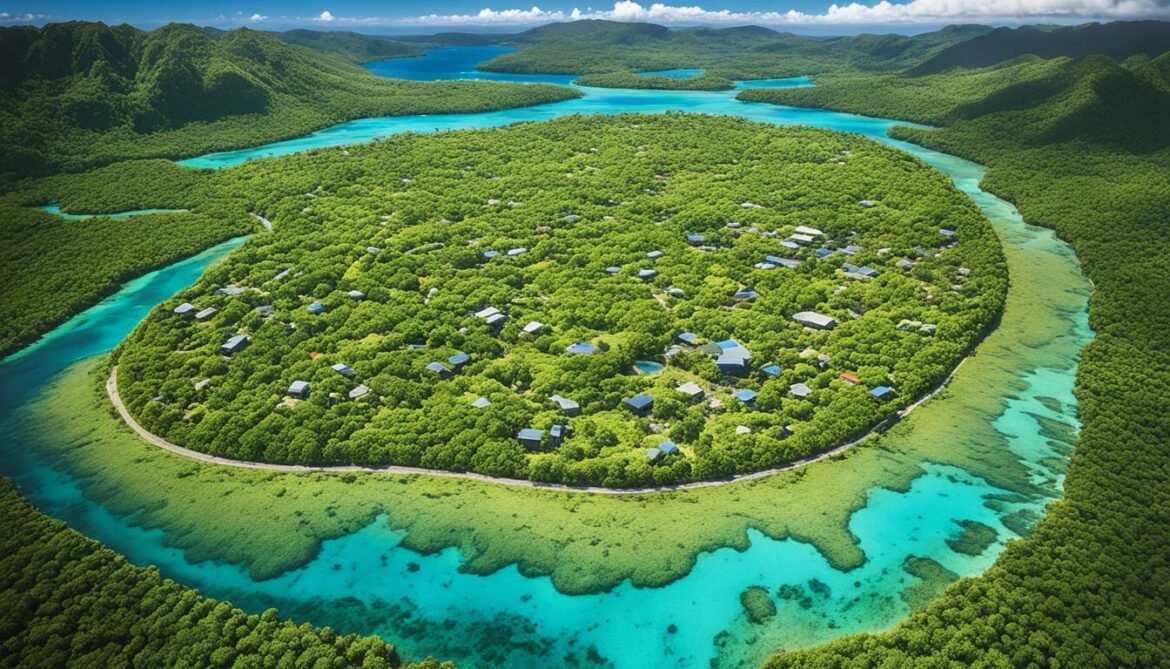
Threats to Vanuatu’s Biodiversity
Vanuatu’s breathtaking biodiversity is currently under threat from various factors, including habitat destruction, over-exploitation, invasive species, and cyclonic events. These threats pose significant risks to the unique ecosystems and species that call Vanuatu home.
Habitat destruction due to agriculture and development is one of the major challenges facing Vanuatu’s biodiversity. As industries expand and urban areas grow, natural habitats are being cleared, leading to the loss of crucial ecosystems that support a wide range of plant and animal species.
Over-exploitation of plant and animal resources is another pressing issue. Unsustainable hunting, fishing, and logging practices can deplete populations and disrupt the delicate balance of Vanuatu’s ecosystems. It is essential to promote responsible resource management to prevent irreversible damage to the environment.
The introduction of invasive species is a significant threat to Vanuatu’s biodiversity. These non-native species can outcompete native plants and animals, leading to the decline or extinction of indigenous species. Controlling and preventing the spread of invasive species is crucial for preserving Vanuatu’s unique ecosystem.
Cyclonic events, such as tropical storms and hurricanes, pose a significant risk to Vanuatu’s biodiversity. These extreme weather events can cause widespread destruction of habitats, leading to the loss of plant and animal species. Mitigating the impact of cyclonic events and implementing disaster management strategies are vital for protecting Vanuatu’s biodiversity.
To combat these threats, it is crucial to promote sustainable land-use practices and implement green building regulations to minimize habitat destruction. Efforts should also be focused on addressing the over-exploitation of valuable resources and controlling invasive species through active management and conservation programs. Additionally, investing in measures to mitigate the impact of cyclonic events is essential for safeguarding Vanuatu’s precious biodiversity.
Importance of Green Buildings in Vanuatu
As Vanuatu experiences a growing demand for buildings, there is a pressing need to prioritize sustainable construction and eco-friendly architecture. Green buildings play a crucial role in enhancing resource efficiency and minimizing environmental impact in the country. The Ministry of Construction in Vanuatu actively supports the adoption of sustainable design and construction methods to create a more sustainable built environment.
One of the key environmental benefits of green buildings is their ability to reduce greenhouse gas emissions, contributing to global efforts to mitigate climate change. By incorporating energy-efficient technologies, sustainable materials, and renewable energy sources, green buildings in Vanuatu promote resource efficiency and conservation.
In addition to their environmental advantages, green buildings also offer significant economic benefits. Through improved energy and water efficiency, green buildings lower operating costs, resulting in long-term financial savings. Moreover, properties with green certifications often command higher resale values and attract environmentally conscious consumers and tenants.
The adoption of sustainable design and construction practices aligns with Vanuatu’s commitment to sustainable development. By creating an environment that prioritizes resource efficiency and minimizes environmental impact, green buildings contribute to a more sustainable future in Vanuatu.
Economic Benefits of Green Buildings in Vanuatu
The economic benefits of green buildings in Vanuatu are substantial. Green buildings help reduce operating costs by optimizing energy and water usage. Efficient lighting systems, insulation, and natural ventilation minimize the need for excessive energy consumption, resulting in lower utility bills. In the long run, these cost savings contribute to a more sustainable and financially viable solution for building owners and occupants.
Environmental Impact of Green Buildings in Vanuatu
Green buildings have a significantly lower environmental impact compared to traditional buildings. By utilizing sustainable materials, minimizing waste generation, and implementing energy-saving technologies, green buildings reduce carbon emissions and conserve natural resources. Additionally, they contribute to the overall health of ecosystems by limiting habitat destruction and preserving biodiversity.
Green buildings provide a sustainable solution for Vanuatu’s built environment, addressing the increasing demand for buildings while minimizing the environmental impact and optimizing resource efficiency.
By embracing green buildings, Vanuatu can create a harmonious balance between development and environmental conservation. The integration of sustainable design and construction practices not only benefits the present but also ensures a sustainable future where businesses, government institutions, and communities thrive while being mindful of the natural environment.
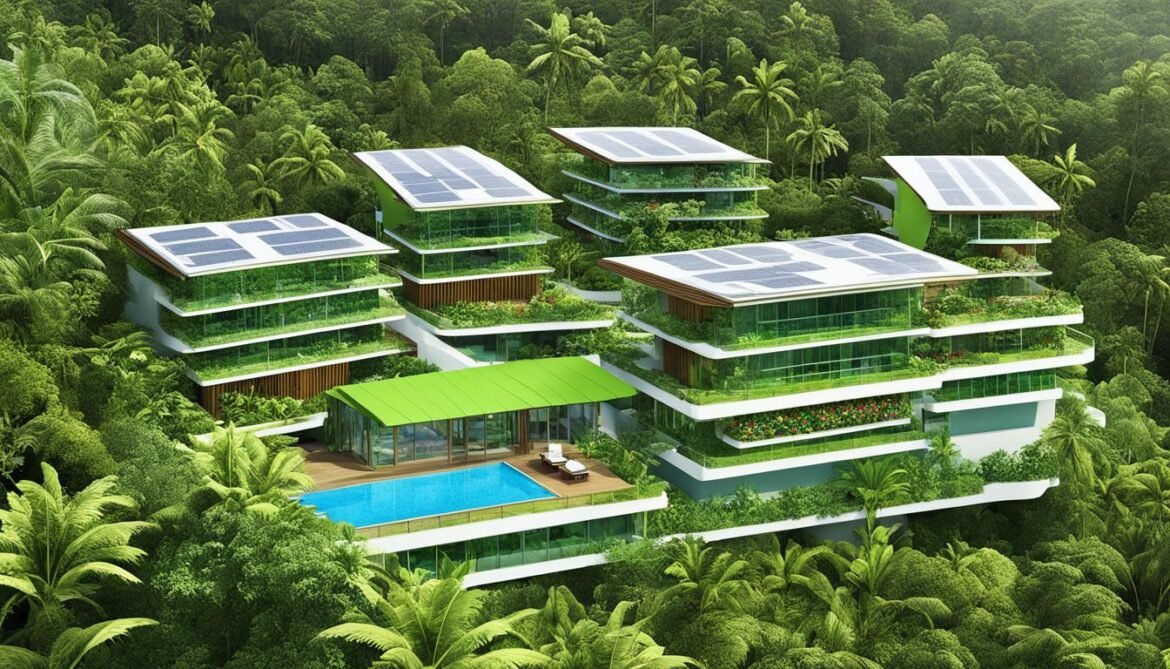
Table: Economic and Environmental Benefits of Green Buildings in Vanuatu
| Benefits | Description |
|———————————|—————————————————————————————————————-|
| Lower operating costs | Green buildings’ energy and water efficiency measures contribute to significant cost savings for building owners. |
| Enhanced property value | Green certifications increase the value and marketability of properties. |
| Reduced greenhouse gas emissions | Green buildings help combat climate change by minimizing carbon footprints. |
| Resource efficiency | Sustainable materials and technologies optimize resource usage, leading to conservation and sustainability. |
| Conservation of water resources | Water-efficient systems and practices reduce water consumption and promote water conservation. |
Investing in green buildings not only makes economic sense but also represents a significant step towards environmental responsibility in Vanuatu. By recognizing the importance of green buildings and implementing sustainable practices, Vanuatu can lead by example in promoting sustainable development and creating a more resilient and sustainable future.
Benefits of Green Buildings in Vanuatu
Green buildings in Vanuatu offer a multitude of benefits that contribute to a sustainable future. These buildings contribute to environmental preservation by reducing greenhouse gas emissions, conserving water resources, and minimizing waste generation. By integrating energy-efficient technologies and sustainable design principles, green buildings play a vital role in reducing carbon footprint and addressing climate change challenges.
Moreover, green buildings bring about economic advantages. They lead to lower operating costs by promoting energy and resource efficiency. From reduced utility bills to maintenance savings, green buildings provide long-term financial benefits for owners and occupants alike. Additionally, these sustainable structures often have enhanced property value, making them attractive investments in the real estate market.
However, the benefits extend beyond the environmental and economic realms. Green buildings prioritize the creation of a comfortable and healthy indoor environment. Through the use of natural lighting, proper ventilation systems, and non-toxic building materials, green buildings enhance occupant well-being and productivity. These sustainable structures promote an improved quality of life for individuals and communities.
Furthermore, green buildings contribute to social cohesion and community engagement. They foster a sense of responsibility towards the environment and encourage individuals to adopt sustainable practices in their daily lives. By exemplifying sustainable development, green buildings inspire others to follow suit and stimulate the demand for sustainable products and services.
“Green buildings play a crucial role in creating a sustainable future by safeguarding the environment, providing economic benefits, and enhancing the well-being of occupants. Their impact goes beyond the bricks and mortar, influencing individuals, communities, and entire societies.”
Evaluating the Benefits of Green Buildings
When assessing the impact of green buildings, it is essential to consider a comprehensive range of factors, including:
- The reduction of greenhouse gas emissions
- The conservation of water resources
- The minimization of waste generation
- The financial savings from lower operating costs
- The enhanced property value
- The creation of comfortable and healthy indoor environments
- The promotion of sustainable development
- The increased demand for sustainable products and services
- The contribution to community engagement and collaboration
By examining these aspects, it becomes evident that green buildings in Vanuatu play a vital role in driving positive change and shaping a sustainable future.
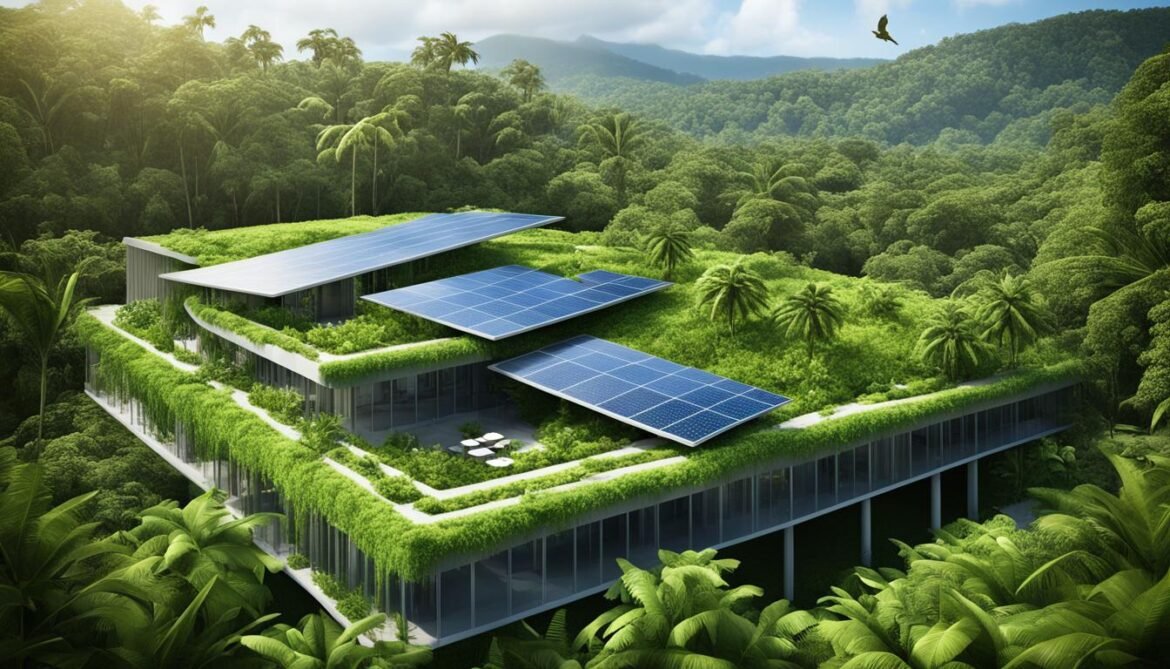
Investment Opportunities in Green Buildings in Vanuatu
Investing in green buildings in Vanuatu presents a significant opportunity for individuals and organizations. With a sustainable construction market worth nearly $80 billion, Vanuatu offers a fertile ground for those seeking attractive financial returns and a positive environmental impact. Green buildings not only contribute to the preservation of Vanuatu’s unique biodiversity but also offer tangible benefits that enhance financial prospects.
One of the key advantages of investing in green buildings in Vanuatu is the potential for higher rental and resale values. As sustainability becomes a priority for tenants and buyers, green buildings command a premium in the real estate market. Apart from the financial returns, green buildings also bring reduced operating costs, making them a financially sound investment option.
The demand for green buildings aligns with the Vanuatu government’s commitment to green building regulations and policies. The government’s support provides a stable foundation for investors, reducing uncertainties and risks associated with green building ventures. By investing in green buildings, individuals and organizations can contribute to Vanuatu’s sustainable development goals and promote a greener future.
Financial Returns
Investing in green buildings in Vanuatu offers attractive financial returns due to:
- Higher rental and resale values
- Reduced operating costs
Environmental Impact
Green buildings in Vanuatu have a positive environmental impact through:
- Reduced carbon emissions
- Water conservation
- Waste reduction
Government Support
The Vanuatu government actively supports the development of green buildings through:
- Green building regulations
- Sustainable construction policies
- Partnerships with international organizations
Investment in green buildings not only offers financial rewards but also contributes to the sustainable development of Vanuatu. By aligning financial interests with environmental responsibility, investors can make a positive impact on the built environment in Vanuatu while reaping the benefits of a thriving market.
| Investment Opportunity | Sustainable Construction Market Worth | Financial Returns | Government Support |
|---|---|---|---|
| Green Buildings in Vanuatu | Nearly $80 billion | Higher rental and resale values, reduced operating costs | Green building regulations, sustainable construction policies, partnerships with international organizations |

Government Support for Green Buildings in Vanuatu
The Vietnamese government has taken significant steps to promote green buildings in Vanuatu and has implemented various policies, initiatives, and regulations to support sustainable development. Recognizing the importance of eco-friendly construction practices, the government has updated technical norms to encourage the adoption of sustainable building methods.
One of the key focuses of the government is energy efficiency. By promoting energy-efficient practices and technologies, such as improved insulation, advanced lighting systems, and renewable energy sources like solar power, Vanuatu aims to reduce energy consumption and carbon emissions, contributing to a greener and more sustainable built environment.
In addition to fostering a stable regulatory environment with green building regulations, the Vanuatu government also actively collaborates with international organizations. These partnerships facilitate knowledge exchange and access to resources that further promote sustainable construction practices in the country. Through these collaborations, Vanuatu can learn from global best practices and implement them within its own regulatory framework to drive sustainable development.
The Vietnamese government’s commitment to promoting sustainable construction practices and supporting green buildings in Vanuatu showcases its dedication to addressing environmental concerns and fostering a sustainable future for the country.
The government’s initiatives and regulations not only benefit the environment but also provide economic opportunities. Investing in green buildings aligns with the government’s vision and policies, giving investors confidence in the market and increasing the potential for financial returns. The stable regulatory environment ensures that green building ventures have the necessary support and guidance from the government to thrive.
By embracing sustainable development initiatives, prioritizing energy efficiency, maintaining a robust regulatory environment, and engaging in partnerships with international organizations, the Vanuatu government is paving the way for a greener future and supporting the growth of green buildings in the country.
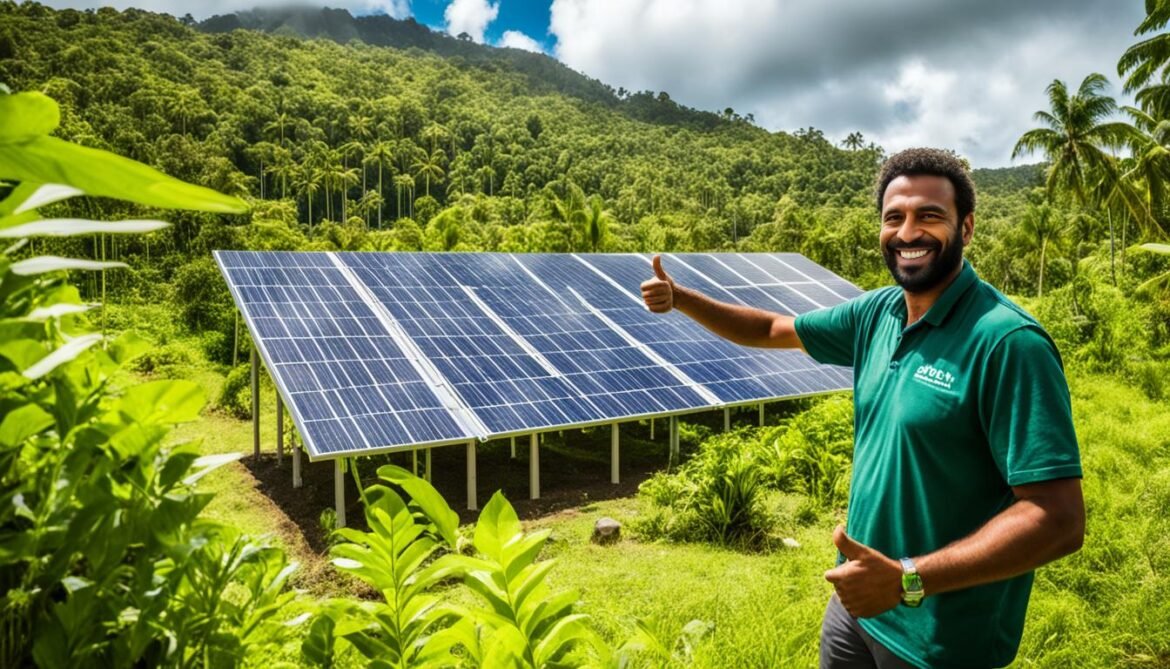
Vanuatu is making significant strides in promoting sustainable building practices and is poised to lead the way in green construction in the Pacific region. With the government’s support and collaboration with international organizations, Vanuatu can continue to drive the development of green buildings and contribute to global efforts in mitigating climate change and preserving the environment.
Sustainable Practices in Vanuatu’s Green Architecture
Green buildings in Vanuatu prioritize the use of eco-friendly materials, energy-efficient design, and the utilization of solar energy. By incorporating these sustainable practices, Vanuatu’s green architecture aims to reduce environmental impact while promoting healthier indoor environments and energy efficiency.
One of the key aspects of sustainable architecture in Vanuatu is the use of eco-friendly materials. These materials are sourced sustainably and have minimal negative impact on the environment. They are typically non-toxic, recyclable, and biodegradable, ensuring that they don’t contribute to pollution or waste. Using eco-friendly materials in construction helps to minimize the carbon footprint of buildings and create a healthier living and working space for occupants.
Another integral element of sustainable practices in Vanuatu’s green architecture is energy-efficient design. Buildings are designed to maximize energy efficiency by incorporating insulation, advanced lighting systems, and natural ventilation. Insulation helps to minimize heat transfer, reducing the need for excessive heating or cooling. Advanced lighting systems, such as LED technology, consume less energy while providing ample illumination. Natural ventilation allows for the circulation of fresh air and reduces the reliance on mechanical cooling systems. These energy-efficient design features contribute to lower energy consumption and decreased greenhouse gas emissions.
The utilization of solar energy is a significant aspect of sustainable practices in green architecture in Vanuatu. Solar panels are installed to harness renewable energy for powering electrical systems and heating water. By utilizing the abundant sunlight in Vanuatu, buildings can reduce their reliance on fossil fuel-based energy sources. Solar energy is a clean and sustainable alternative, contributing to a more environmentally friendly and energy-independent future.
In addition to eco-friendly materials and energy-efficient design, sustainable architecture in Vanuatu also promotes habitat modification through the integration of green spaces, green walls, and green roofs. These features create opportunities for displaced wildlife and contribute to the establishment of urban ecosystems. Green spaces provide habitats for plants and animals, enhancing biodiversity and promoting a healthier environment. Green walls and green roofs further improve air quality, reduce heat island effect, and create visually appealing and sustainable urban landscapes.
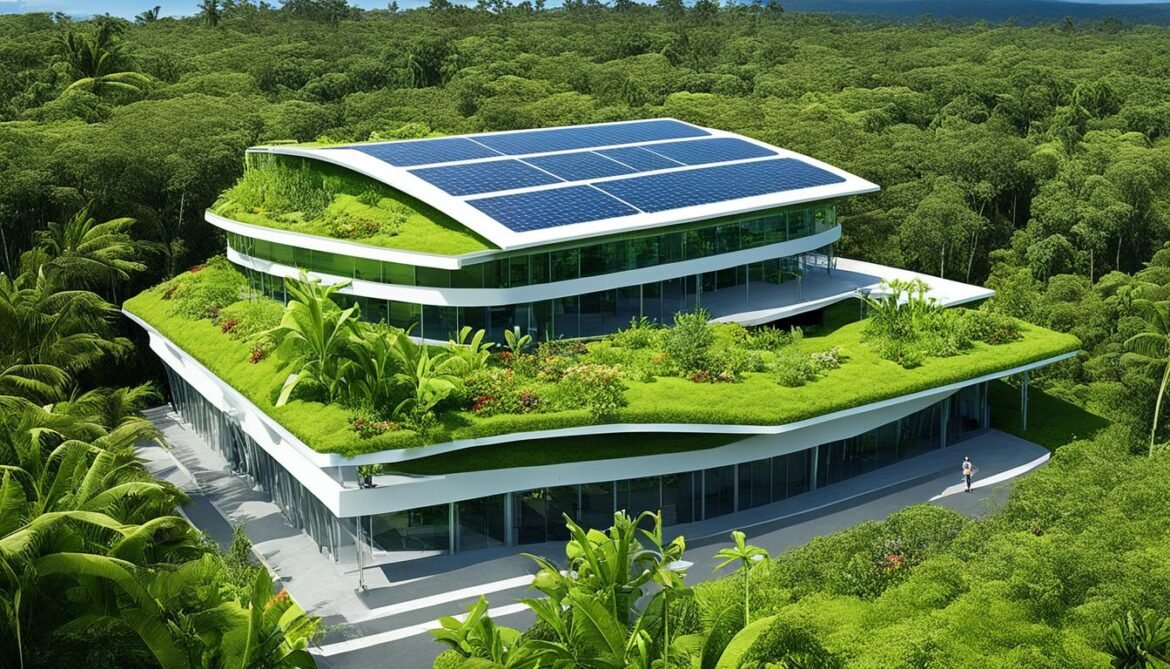
Sustainable practices in Vanuatu’s green architecture play a crucial role in promoting environmental conservation and creating a sustainable future. Through the use of eco-friendly materials, energy-efficient design, solar energy utilization, and habitat modification, Vanuatu is laying the foundation for a greener and more sustainable built environment.
Conclusion
Vanuatu’s rich biodiversity and the importance of sustainable development are deeply connected. Conservation efforts and the adoption of green building practices are crucial for ensuring a sustainable future for Vanuatu. By protecting its unique biodiversity, implementing sustainable construction methods, and embracing eco-friendly architecture, Vanuatu can contribute to environmental conservation and create a brighter future for generations to come.
Vanuatu has the potential to make a significant impact on biodiversity decline by initiating restoration projects and implementing green building regulations. Prioritizing biodiversity and sustainable development will allow Vanuatu to strike a harmonious balance between human activities and the natural environment. Through these efforts, Vanuatu can not only protect its natural heritage but also serve as an example and inspiration for other countries facing similar challenges.
With a commitment to conservation and the integration of green building practices, Vanuatu can build a sustainable future that benefits both the environment and its people. The preservation of biodiversity, the implementation of sustainable construction methods, and the embrace of eco-friendly architecture are all essential elements in creating a more sustainable and resilient Vanuatu. By working together, we can protect Vanuatu’s unique biodiversity and pave the way for a greener and more sustainable world.





